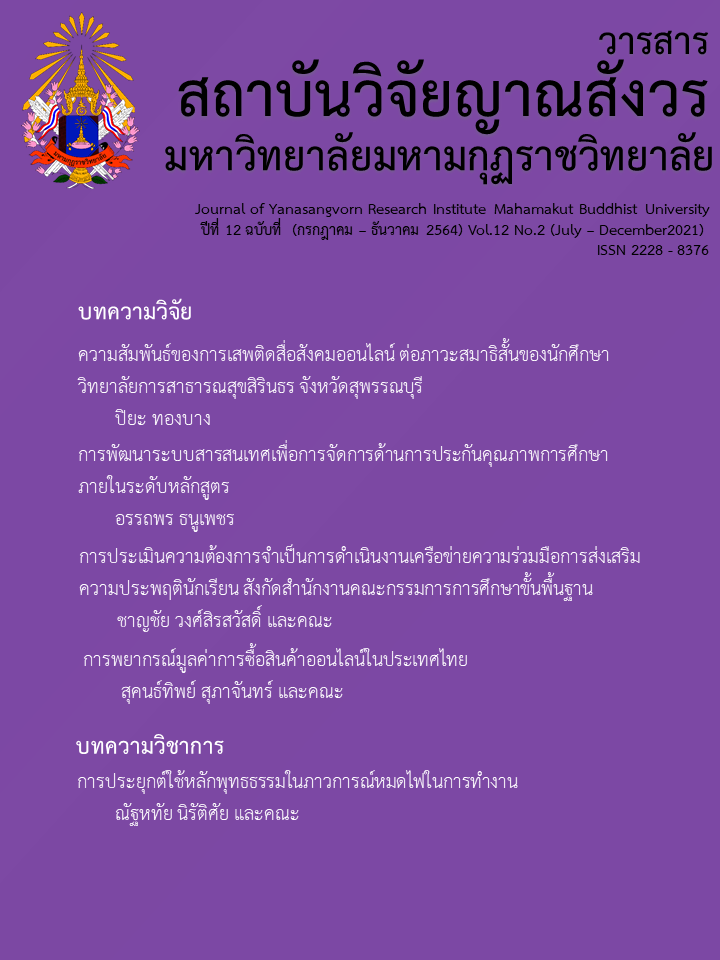THE RELATIONSHIP OF SOCIAL MEDIA ADDICTION ON ADHD AMONG COLLEGE STUDENTS SIRINDHORN PUBLIC HEALTH SUPHANBURI
Main Article Content
Abstract
This research aimed to study the behavior of social media addiction. To study ADHD And to study relationships and compare social media addiction behaviors Classified by personal factors Samples used in the research Is a student of Sirindhorn College of Public Health Suphanburi Province, number 181 people. The tools used were the Thai version of the Social Media Addiction Questionnaire and the Adult ADHD Self-Report Scale (ASRS) Screener V1.1, analyzed using t-test statistics and one-way variance analysis. (One way ANOWA) The research results show that.
- The results of the study of social media addiction behavior among students showed that the social media addiction behavior was at the level of social media frenzy.
- The results of the students' ADHD study found that an indication of ADHD symptoms in adults, most of the students had no symptoms of ADHD in adults.
3. The results of a correlation study and comparison of social media addiction behaviors By personal factors and ADHD among students, it was found that the relationship between sex, level, school year The controversy and the average monthly cost of using the social network It is associated with ADHD in adults. Was statistically significant at the 0.05 level, and when comparing behavior, it was found that the difference between personal factors It has no effect on social media addiction behaviors.
Article Details
References
เฉลิมพล ก๋าใน, ดาราวรรณ ต๊ะปินตา และสมบัคิ สกุลพรรณ. (2561). ความสัมพันธ์ระหว่างการติดเฟชบุ๊คและภาวะซึมเศร้าของวัยรุ่นในสถานบันอุดมศึกษาของรัฐ จังหวัดเชียงใหม่. วารสารเครือข่ายวิทยาลัยพยาบาลและการสาธารณสุขภาคใต้, 5(2), 57-69.
เต็มหทัย นาคเทวัญ และจตุรพร แสงกูล. (2563). การตรวจคัดกรองโรคสมาธิสั้นในผู้ใหญ่และปัจจัยที่สัมพันธ์ในนักศึกษาชั้นปีที่ 1 มหาวิทยาลัยสงขลานครินทร์. วารสารสุขภาพจิตแห่งประเทศไทย, 25(1), 16 – 29.
ตันติกร ชื่มเกษม. (2562). ความสัมพันธ์ของการเสพติดสื่อสังคมออนไลน์ที่มีต่อการใช้เวลากับ ครอบครัวของนักเรียนระดับมัธยมศึกษาในเขตประเวศ กรุงเทพมหานคร. วิทยานิพนธ์หลักสูตรรัฐศาสตรมหาบัณฑิต สาขาวิชายุทธศาสตร์และความมั่นคง คณะรัฐศาสตร์และ นิติศาสตร์ มหาวิทยาลัยบูรพา.
พรพรรณ จันทร์แดง. (2559). พฤิตกรรมการใช้สื่อสังคมออนไลน์ของนิสิตระดับปริญญาตรี มหาวิทยาลัยพะเยา. วารสารมนุษยศาสตร์และสังคมศาสตร์ มหาวิทยาลัยพะเยา, 4(2), 44 – 54.
สำนักงานพัฒนาธุรกรรมทางอิเล็กทรอนิกส์ (องค์การมหาชน). (2559). รายงานผลการสำรวจพฤติกรรมผู้ใช้อินเตอร์เน็ตในประเทศไทย 2559. สืบค้นเมื่อ 2 ตุลาคม 2563. https://data.go.th/dataset/item_6aa9b49a-84b3-4c30-8821-322c165efd29.
White, C. M. (2011). Social media, crisis communication, and emergency management: Leveraging Web 2.0 technologies. CRC press.


